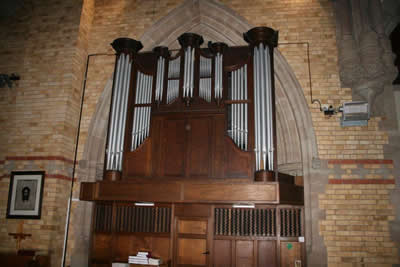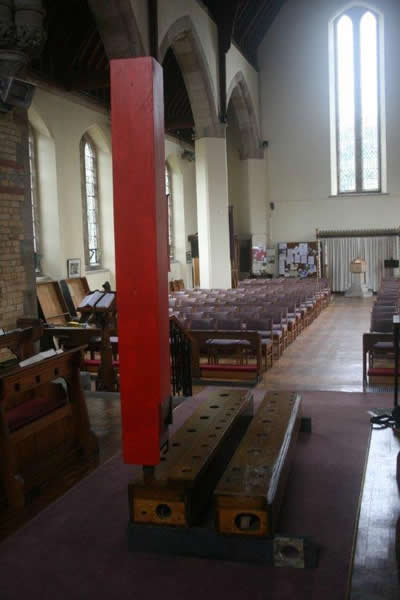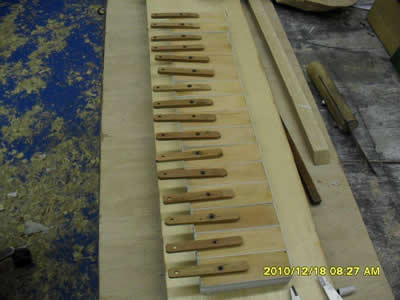A new organ for St Matthias & St George
 As I write this we are working on site to install the new organ for St Matthias & St George, Astwood Bank, Redditch in the West Midlands.
As I write this we are working on site to install the new organ for St Matthias & St George, Astwood Bank, Redditch in the West Midlands.
The chancel dates back to 1884, however the nave, which although relatively short is also quite lofty, was built 100 years ago this year. Since then the church has possessed four organs and is about to have its fifth, installed in a large first floor chamber at the base of what should have been the tower but was never completed.
The previous organs are generally known, thanks in part to the National Pipe Organ Register (www.npor.org.uk), consequently our research work has been easier, and all previous organs have been of two manuals and pedals. There are photographs and extensive details of the 1949 organ, a large two manual instrument by Kingsgate Davidson of London, which lasted only until 1965 when a Walker extension organ was installed, wholly enclosed except for the Bourdon basses. Additional work was done in 1982 adding an Open Diapason rank to make the organ louder in the church. This organ whilst adequate, never quite had the versatility that reeds and strings would have added, and was conceived by the then organist to play some of his favourite repertoire, Baroque music, particularly Bach Trio Sonatas.
 Forty-five years later, this organ was removed to make way for the ‘new’ three manual organ by ourselves. We say new, and it certainly is new to the church, but almost all the pipework is secondhand, as are the reservoirs (bellows), some of the unit chests and the console, although the latter has been extensively rebuilt. The core of the organ is the 1850 Walker organ from St Andrew, Cobham in Surrey, and a significant amount of the 1911 Conacher from Ramsgate Baptist Church. In addition, the previous organ’s pipework has been entirely re-used, as well as ranks by Henry Willis, Gray & Davison, Norman & Beard, Ravensdale and Mander, together with some ranks of uncertain origin.
Forty-five years later, this organ was removed to make way for the ‘new’ three manual organ by ourselves. We say new, and it certainly is new to the church, but almost all the pipework is secondhand, as are the reservoirs (bellows), some of the unit chests and the console, although the latter has been extensively rebuilt. The core of the organ is the 1850 Walker organ from St Andrew, Cobham in Surrey, and a significant amount of the 1911 Conacher from Ramsgate Baptist Church. In addition, the previous organ’s pipework has been entirely re-used, as well as ranks by Henry Willis, Gray & Davison, Norman & Beard, Ravensdale and Mander, together with some ranks of uncertain origin.
There is much new work in the organ, including the electrical system, soundboards and substantial parts of the console. New slider soundboards have been built for the Great, Swell & Choir, and the console has received additional drawstops to encompass the new specification. This has involved redesigning the Compton console to take stop jambs of increased height, as well as the addition of numerous playing aids, ensuring comprehensive control of the instrument by the player. The electrical switching and capture system, including 64 channels of memory and a sequencer has been built by Musicom Ltd, and is both versatile and creative in its use of technology, whilst providing elements, particularly in the control interface, of elegance and ease of use. The connection between the console, which will be moveable, and the organ chamber, is by Cat5 cable, a far cry from the earlier system which used hundreds of individual wires. In addition to the usual couplers and accessories the organ has been fitted with a divided pedalboard, which enables the player to couple different sounds to the top and bottom halves of the pedalboard, and some unusual couplers, including Great to Choir and Swell Reeds on Great, the latter disabling the Swell Reeds from the Swell Manual while coupling them down to the Great Organ simultaneously.
 Tonally, the organ is eclectic, relying heavily on the Englishness of the original material, with an essence of the French romantic. At 53 speaking stops, some 55 ranks with little borrowing on the manuals, the organ appears large on paper. At a little under 3,000 pipes the organ is bigger than average, however what is significant is that the specification is designed to be versatile and comprehensive rather than loud (although it will be louder than the old organ!). Variety of tone has been significant in the design, with each department having Principals, Flutes, Strings, and Reeds, and independent Mixtures occurring on two different manual departments and the pedals; in fact the Great has two compound stops, a three-rank Mixture and a four-rank Fourniture. There is a Gamba in each manual department and Violone on the Pedal, creating a useful homogeneity of tone between departments whilst helping with greater versatility; nine separate reed ranks, chorus reeds on the Swell and Pedal, as well as a Trumpet available on both the Great and Choir, and voiced to bridge the gap between a chorus and solo reed; a four foot Chalumeau on the Pedal and an enclosed Voix Humaine in the Swell.
Tonally, the organ is eclectic, relying heavily on the Englishness of the original material, with an essence of the French romantic. At 53 speaking stops, some 55 ranks with little borrowing on the manuals, the organ appears large on paper. At a little under 3,000 pipes the organ is bigger than average, however what is significant is that the specification is designed to be versatile and comprehensive rather than loud (although it will be louder than the old organ!). Variety of tone has been significant in the design, with each department having Principals, Flutes, Strings, and Reeds, and independent Mixtures occurring on two different manual departments and the pedals; in fact the Great has two compound stops, a three-rank Mixture and a four-rank Fourniture. There is a Gamba in each manual department and Violone on the Pedal, creating a useful homogeneity of tone between departments whilst helping with greater versatility; nine separate reed ranks, chorus reeds on the Swell and Pedal, as well as a Trumpet available on both the Great and Choir, and voiced to bridge the gap between a chorus and solo reed; a four foot Chalumeau on the Pedal and an enclosed Voix Humaine in the Swell.
The full specification is given below:
Finally the existing case is being re-used and fully restored. The origins of this case are unknown, with many believing it to be from an earlier house organ, being enlarged and extended when installed in the church. The casework itself is being restored whilst the display pipes are being restored, cleaned and put back on speech after many years. Twenty-two of the display pipes were speaking pipes, with space for two further pipes in the outside towers, while the remaining pipes in the display are wooden dummies. The speaking pipes will be returned to life as the Choir Gamba.
This has been an exciting project for us as organ builders and, as the largest project we have completed to date, a significant challenge. We have embraced the project with enthusiasm, both for its technical opportunities and musical versatility that the organ will display. As a performer, it is an organ that will be capable of realising the vast majority of the organ repertoire with some degree of authenticity.
Jonathan Lane & Associates Ltd can be contacted view their website: www.organ-builder.co.uk
Jonathan Lane is Managing Director of Jonathan Lane & Associates Ltd. He trained first as a communications engineer and subsequently as a musician. Having spent twenty-five years working as a professional music teacher, organist and choir trainer in a number of churches and at Londonderry Cathedral, he started Jonathan Lane & Associates in 2005, becoming a limited company in 2010. The company has two staff at present, Jonathan and a Budapest trained organ builder, Ferenc Dobos, and has a growing reputation and cliental in the South and Midlands.






